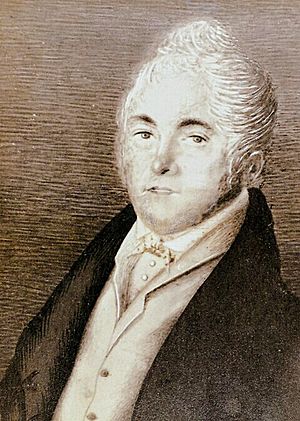Juan Nicolás Böhl de Faber facts for kids
Quick facts for kids
Juan Nicolás Böhl de Faber
|
|
|---|---|
 |
|
| Born |
Johann Nikolaus Böhl und Lütkens
9 December 1770 |
| Died | 11 September 1836 (aged 65) |
| Occupation | Bibliophile and hispanist |
| Movement | Romanticism |
| Spouse(s) | Frasquita Larrea |
| Children | Fernán Caballero (daughter) |
Juan Nicolás Böhl de Faber (born in Hamburg, Germany, in 1770, and died in Cádiz, Spain, in 1836) was a German man who loved Spanish books, stories, and culture. He was a bibliophile, which means someone who collects and loves books. He was also a hispanist, meaning he studied and admired Spanish culture. His daughter, Cecilia Böhl de Faber, became a famous writer known as "Fernán Caballero".
Contents
Juan Böhl de Faber's Life in Spain
Juan Böhl de Faber began his life in Spain working at a shop. This shop belonged to his parents, who were part of the bourgeois class. This means they were middle-class people who owned businesses.
His Work and Family
Besides working in the shop, Juan also served as a consul for his hometown of Hamburg. A consul is like a representative for their country in another place. He also looked after warehouses for important businessmen.
In Cádiz, he met Frasquita Larrea. She was a well-educated lady who spoke French and German. She enjoyed reading famous writers like Shakespeare and Mary Wollstonecraft. Juan and Frasquita got married in 1790.
They lived for a short time near Lake Geneva in Switzerland. Their daughter, Cecilia, who would later become the writer Fernán Caballero, was born there. They later had two more children.
Returning to Spain
The family returned to Spain and lived in Cádiz. They helped create a lively cultural scene there. They started the first tertulias, which were social gatherings where people discussed books and ideas.
In 1805, Juan and Frasquita traveled to Germany again. After this trip, Frasquita returned to Spain alone. She and her two daughters lived through the Peninsular War in Chiclana de la Frontera. The family later reunited in Cádiz after the war ended.
Böhl de Faber's Love for Spanish Culture
Juan Böhl de Faber loved Spanish culture very much. He collected many Spanish books and built a large library. While in Germany, he found many writings by the brothers August Wilhelm Schlegel and Friedrich Schlegel. These writings were about art, literature, and especially the plays of Pedro Calderón de la Barca.
Spreading New Ideas
In 1814, Juan published an article in a newspaper. It was called "Schlegel's Reflections upon Theatre as Translated from German." In this article, he connected Romanticism with absolutism. Romanticism was a new way of thinking that focused on feelings and tradition. Absolutism meant a strong, traditional government, often led by a king.
Juan's article argued for a return to traditional and Catholic ideas. It criticized the ideas of the Age of Enlightenment, which focused on reason and science. He praised Spanish nationalism and said that Calderón de la Barca's plays were a symbol of the Spanish spirit. He believed that disliking Calderón's work was unpatriotic.
Debates and Arguments
However, not everyone agreed with him. A writer named José Joaquín de Mora argued that Calderón's plays were actually bad for Spanish culture. This started a big debate between Juan and Mora. Their arguments appeared in newspapers in Madrid.
Between 1818 and 1819, Juan published more articles. He defended the Spanish theater from the Siglo de Oro (Golden Age). This type of theater was disliked by Spanish Neo-Classicists. Neo-Classicists preferred a simpler, more orderly style of art and literature.
Mora and Antonio Alcalá Galiano, who were liberal writers, strongly disagreed with Juan. They were against his traditionalist views. The arguments became very heated and personal.
Böhl de Faber's Legacy
Despite the arguments, Juan Böhl de Faber continued to write and publish. His work helped bring traditional Romanticism to Spain. He wrote about English poetry that was influenced by Romanticism.
When the Trienio Liberal ended in the 1820s, Mora and Alcalá Galiano left Spain. To argue better against Juan, they had to study the ideas of Schlegel. This is how Romanticism became more known in Spain. Juan Böhl de Faber actually became one of the first people to introduce it to the country.
Juan connected Christianity with Romanticism. He believed that Romanticism had already existed in medieval Spain. He thought that Neo-Classicism was just a break from Spain's true cultural traditions. He also published essays about other famous Spanish writers like Lope de Vega and Calderón de la Barca. He also collected old Spanish poems and popular songs.
See also
 In Spanish: Juan Nicolás Böhl de Faber para niños
In Spanish: Juan Nicolás Böhl de Faber para niños

